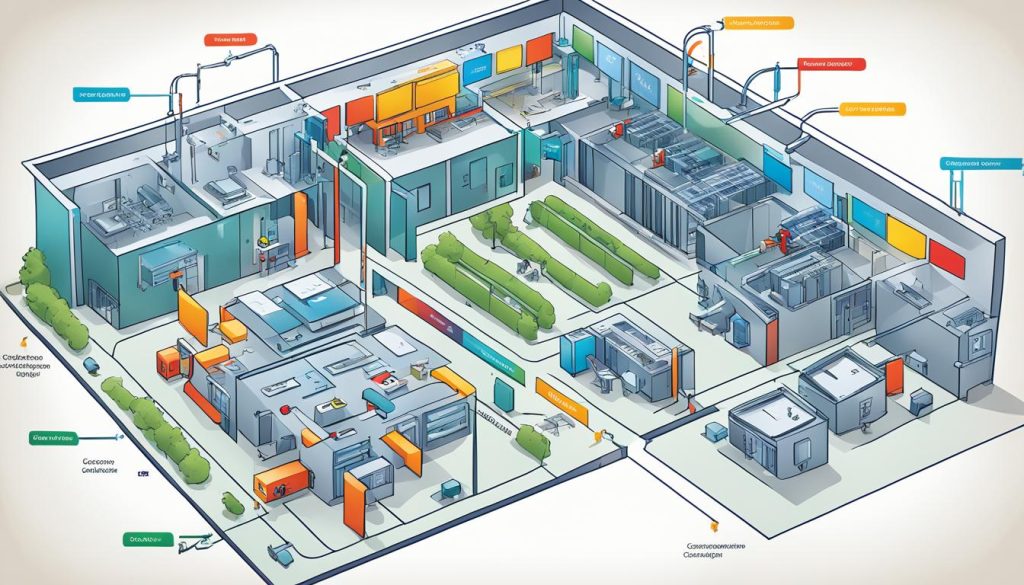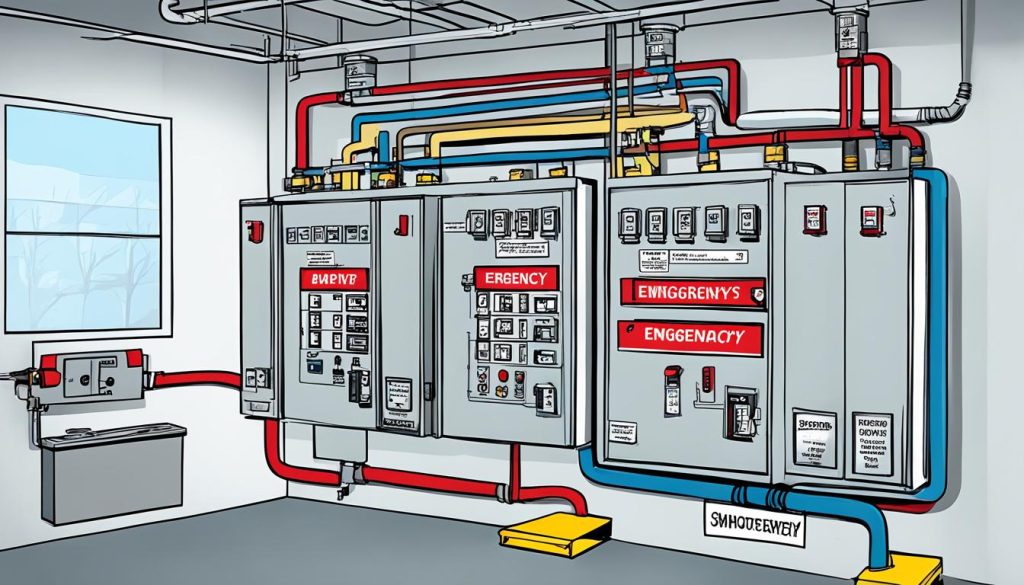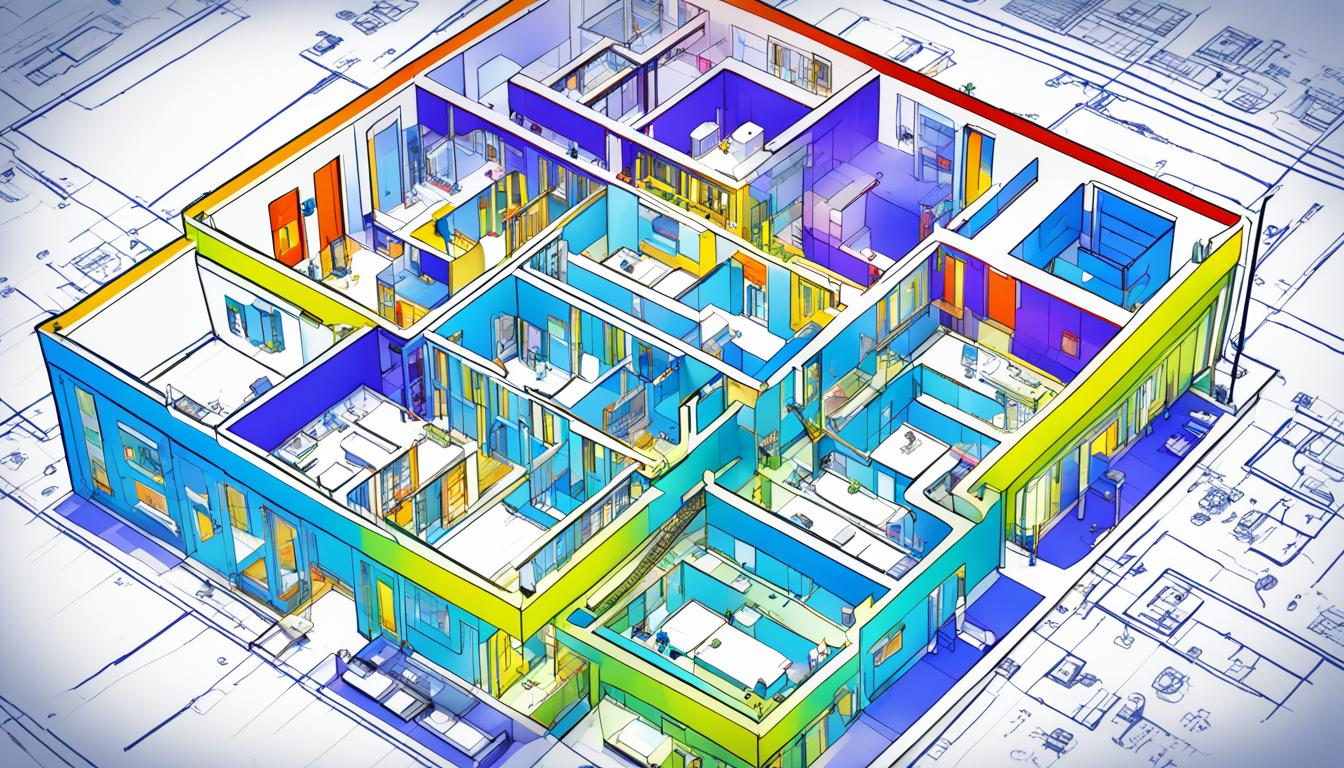You can make smart HVAC control systems with CAD software for building management. These programs help you create, change, and improve heating, ventilation, and air conditioning systems. They make it easier to work with precision and efficiency.
HVAC CAD software lets you draw complex ductwork, piping, and HVAC parts. It has libraries of standard parts, does thermal load calculations, and simulates energy use. It also works well with Building Information Modeling (BIM) systems, making it easier to work with other construction teams.
Using HVAC CAD software for smart control systems makes projects more accurate and saves time. It also helps teams work together better. This tool is essential for making buildings more energy-efficient and sustainable. It helps you improve HVAC performance and work well with building management systems.
Understanding Smart HVAC Control Systems
Smart HVAC control systems are changing how we manage buildings. They use the latest technology to make heating, cooling, and ventilation better in all types of buildings. These systems use automation and energy-saving methods to make buildings more comfortable and efficient.
Definition and Components of Smart HVAC Systems
Smart HVAC systems are made up of devices that work together to keep the inside of buildings just right. The main parts are:
- IoT sensors for checking temperature, humidity, and how many people are around
- Smart thermostats for controlling the temperature accurately
- Variable speed HVAC equipment for saving energy
- Cloud-based HVAC control platforms for managing from afar
Benefits of Intelligent HVAC Control
Using smart building systems has many benefits:
| Benefit | Description |
|---|---|
| Energy Savings | Can cut energy use by up to 30% |
| Improved Comfort | Control temperature and humidity precisely |
| Cost Reduction | Lower bills and less maintenance costs |
| Environmental Impact | Less carbon emissions from efficient use |
Integration with Building Management Systems
Smart HVAC controls work well with building management systems. This lets managers control everything from one place, like lights, security, and energy use. Using IoT sensors and cloud-based control, managers can make buildings run better and keep people more comfortable.
The Role of CAD Software in HVAC Design
CAD software is key in modern HVAC design. It changes how engineers design efficient heating, ventilation, and air conditioning systems. Let’s look at the benefits, top choices, and main features of HVAC design software.
Advantages of using CAD for HVAC planning
HVAC design software brings many benefits:
- Increased accuracy in system layouts
- Improved efficiency in the design process
- Enhanced visualization through 3D modeling
- Easier collaboration among team members
- Reduced errors and rework
This leads to better HVAC systems and saves a lot of time.
Popular CAD software options for HVAC design
There are many CAD/CAM for HVAC options:
- Autodesk Revit: Offers powerful BIM integration
- SolidWorks: Known for its robust 3D modeling capabilities
- ANSYS: Provides advanced HVAC simulation tools
- Fusion 360: Combines design, engineering, and manufacturing features
Each software has its own strengths, fitting different HVAC design needs.
Key features to look for in HVAC-specific CAD tools
When picking HVAC design software, look for these key features:
- BIM integration for comprehensive building management
- Computational fluid dynamics (CFD) analysis
- Energy modeling capabilities
- Compatibility with industry standards
- Parametric design tools for quick iterations
These features make sure your HVAC designs work well, meet standards, and fit with other building systems.
Preparing for Smart HVAC System Design
Before starting on smart HVAC system design, you must prepare well. This begins with a detailed building analysis. Energy audits are essential to understand how energy is used now and where it can be better.
Then, focus on load calculations. These are key to figuring out the right size and power of your HVAC equipment. Getting load calculations right ensures your system works well without overworking or not enough.
Think about these things when getting ready for your smart HVAC design:
- Climate conditions of your location
- Building orientation and envelope
- Occupancy patterns
- Local regulations and codes
- Existing system data (if applicable)
Set clear goals for your new system. Decide on comfort levels, energy efficiency goals, and budget limits. These are the basics of your HVAC system needs.
Working together is important at this stage. Team up with architects, engineers, and facility managers. Their advice helps make sure your HVAC design covers everything needed for building management.
By getting ready well and thinking about all these points, you’re setting up for a great smart HVAC system design. It will meet your building’s specific needs and be very efficient.
Design Smart HVAC Control Systems Using CAD Software
CAD software changes the game in HVAC control design. It lets you model systems precisely and integrate them efficiently. You can make detailed layouts, use smart algorithms, and place sensors perfectly for the best performance.
Creating System Layouts and Schematics
Begin by making detailed control schematics with CAD tools. Show where ductwork, piping, and equipment go with exact sizes. This helps spot problems early and makes installing easier.
Implementing Control Algorithms
Make smart HVAC algorithms to run the system well. CAD lets you set up complex control rules, like how occupancy, temperature, and humidity affect things. Test these rules virtually to make sure they work best before you start.
Integrating Sensors and Actuators
Putting sensors in the right spots is key for real-time checks and tweaks. Use CAD to figure out where to put sensors in the building. Think about different sensors:
- Temperature sensors
- Humidity sensors
- Occupancy sensors
- CO2 sensors
- Pressure sensors
Put actuators where they can control things like dampers and valves based on sensor info. This setup is the core of your smart HVAC system.
| Component | Function | CAD Design Consideration |
|---|---|---|
| Temperature Sensor | Monitor room temperature | Place away from heat sources |
| Occupancy Sensor | Detect presence for demand-based ventilation | Cover entry points and high-traffic areas |
| Damper Actuator | Control airflow in ducts | Ensure accessibility for maintenance |
| Valve Actuator | Regulate water flow in heating/cooling systems | Include in piping schematics |
Using CAD for HVAC modeling sets the stage for efficient, smart, and energy-saving climate control.
Optimizing Energy Efficiency Through CAD-Based Design
CAD-based design changes the game in HVAC energy modeling, leading to sustainable HVAC designs. It uses advanced software to simulate how buildings work under different conditions. This helps find the most efficient solutions.
Green building design begins by testing different equipment setups and control methods. CAD tools help see how design elements affect HVAC loads. This leads to a more energy-efficient system.
Simulating HVAC efficiency lets you check out energy-saving features like heat recovery and smart zoning. These simulations show how much you can save and the environmental benefits. They help guide your choices towards sustainability.
| Feature | Energy Savings Potential | Environmental Impact |
|---|---|---|
| Heat Recovery | 15-30% | Reduced CO2 emissions |
| Variable Speed Drives | 20-50% | Lower electricity consumption |
| Smart Zoning | 10-25% | Improved thermal comfort |
Adding renewable energy sources to your HVAC design boosts energy efficiency even more. CAD software lets you model solar panels and geothermal systems. It optimizes their placement and performance in the building.
Integrating HVAC Controls with Building Management Systems
Smart building automation needs smooth BMS integration. HVAC controls are key in this process. By linking your HVAC to the building management system, you get a single platform. This platform boosts efficiency and comfort.
Protocols for BMS Integration
HVAC control protocols help systems talk to each other. The top protocols are:
- BACnet: Used a lot in building automation
- Modbus: Common in industrial settings
- LonWorks: Flexible for different building systems
These protocols let IoT for HVAC work well. They help devices talk and share data.

Data Exchange and Communication Standards
Good data exchange is key for smart buildings. Standards like ASHRAE’s BACnet make HVAC parts talk to the BMS. This lets you monitor and control systems in real-time.
Creating a Unified Control Interface
A single control interface is the aim of BMS integration. This platform lets facility managers:
- Watch all building systems
- Control HVAC and other gear
- Look at energy use
- Do predictive maintenance
By linking HVAC controls with your BMS, you get a strong tool. This tool helps manage your building’s environment and energy use well.
| Feature | Benefit |
|---|---|
| Centralized control | Makes managing building systems easier |
| Real-time data | Helps respond quickly to changes |
| Energy analytics | Improves efficiency and cuts costs |
| Predictive maintenance | Lowers downtime and repair costs |
Simulating and Testing HVAC Performance in CAD Environments
CAD tools are powerful for simulating and testing HVAC performance. They let designers optimize systems before they’re installed. This saves time and cuts costs. Let’s see how these tools change HVAC design and setup.
Software for testing HVAC systems lets engineers make virtual models. These models are perfect for detailed analysis and tweaks. With CFD analysis, designers can see how air moves, temperatures spread, and pollutants spread accurately.
Virtual commissioning is a big deal. It tests control strategies and system reactions safely online. This finds problems early, avoiding expensive fixes later.
Digital twin technology goes further. It makes a virtual copy of the HVAC system that updates live. This means constant performance tweaks and predictive maintenance.
| Simulation Tool | Key Benefits | Applications |
|---|---|---|
| CFD Analysis | Accurate airflow prediction | Ductwork design, room comfort analysis |
| Virtual Commissioning | Risk-free system testing | Control strategy validation, fault detection |
| Digital Twin | Real-time system monitoring | Predictive maintenance, energy optimization |
Using these advanced tools ensures your HVAC system works well in all conditions. This means better energy use, more comfort for people, and a longer system life.
Ensuring Compliance and Safety in Smart HVAC Design
Smart HVAC design needs careful focus on safety and following rules. You must follow HVAC safety standards and ASHRAE guidelines. This ensures your systems work well and are safe. Let’s look at the main points of following rules, safety features, and keeping records in HVAC design.
Regulatory Considerations for HVAC Systems
Following HVAC codes is key for getting your project approved and keeping people safe. You should know the local building codes, energy efficiency rules, and industry standards. ASHRAE guidelines are a great resource for HVAC design and operation best practices.

Safety Features and Fail-Safes in Control Design
Adding fail-safe controls in HVAC systems is vital to stop failures and keep people safe. These features include:
- Emergency shutdown mechanisms
- Temperature and pressure limits
- Ventilation safeguards
- Fire detection and suppression integration
Documentation and Approval Processes
Good HVAC design documents are crucial for getting approval and for maintenance later. Your CAD software can make detailed reports and drawings needed for compliance. Important documents are:
| Document Type | Purpose | Contents |
|---|---|---|
| System Schematics | Visual representation of HVAC layout | Component locations, ductwork, piping |
| Control Diagrams | Illustrate system operation | Sensor locations, control logic, setpoints |
| Load Calculations | Justify system sizing | Heat gain/loss data, equipment capacities |
| Energy Models | Demonstrate efficiency | Annual energy use, cost projections |
By focusing on these areas, you can design smart HVAC systems that follow all rules and put safety first. This sets the stage for a successful setup and start-up.
Implementing and Commissioning Smart HVAC Systems
You’re ready to bring your smart HVAC design to life. The process starts with coordination between design and construction teams. Your CAD models guide the installation, making sure every part fits perfectly.
Next, comes smart HVAC commissioning. This step tests all control systems, sensors, and actuators. You’ll make sure everything works right, adjust control algorithms, and set sensors accurately for the best performance. It’s important to link your HVAC controls with other building systems during this phase.
Now, HVAC control programming makes your system “smart”. You’ll set up algorithms and rules for how your HVAC reacts to different conditions. This needs patience and care to make sure your system uses energy efficiently and keeps people comfortable.
The last step is the system handover. You’ll give detailed info on the system’s setup and control strategies. Make sure to train facility managers and users on using the new system well. With the right setup and training, your smart HVAC system will keep buildings comfy and efficient for a long time.





0 Comments